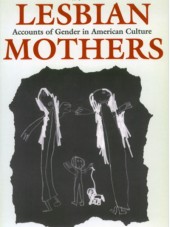Lesbian Mothers
by Ellen Lewin
Published by Cornell University Press
Published May 1993
Nonfiction, ethnography
256 pages
Hardcover or paperback available through Amazon.com
Review by Daniel Kandris
Submitted May 2007
Lesbian Mothers began with a tremendous amount of potential but faltered early. It soon became difficult to determine what Ellen Lewin was trying to establish in terms of lesbian mothers.
It is very clear that Lewin possesses a great deal of ambition for the subject matter and that she has been conducting such a study for many years, but the purpose of such a study is lacking in her observations and explanations. Clearly there are some differences between heterosexual mothers and lesbian mothers, but why write a book that appears to have been designed to illustrate the slight differences and also to point out the similarities so that in the end Lewin could say that lesbians are fit to be mothers?
In terms of examining this book and drawing my conclusions from it, I took Lewin at face value and I accepted her study, despite its flaws, as completely genuine and well planned. I also gave Lewin the benefit of the doubt that this study was completely non-objective.
The other element of examining this book that I used was my own personal experience of being a child raised by lesbians. In having 22 years under my belt as the son of a lesbian and a child that grew up with no father at all, I think that it is safe to say that a lesbian is a fit parent, and I applaud Lewin for illustrating this fact in her book. In terms of her method of research, however, I feel that she focused too much on heterosexual mothers and not enough on the lesbians. I also feel as though it is a shame that the majority of the lesbian parents that she interviewed were previously married rather than women who at one point or another had promiscuous sex and became pregnant.
The organization of this book was well done because it was as if each section was divided into the order of rationale that both lesbians and their children go through in the early stages of their lives together. There is the mother coming out as a lesbian, followed by the loss or gain of a support system, followed by the growth of the child’s curiosity and environment outside of the home, and finally with the “roommate” situation and things that arise as the child gets older. In terms of this construct I think that the Lewin did a great job in taking the reader through these various steps. The candidacy of the interviews was also illustrated extremely well and I think that the flow of each interview really aided this book in terms of readability.
The main issue in Lewin’s research is that there is no main focus on the mothers and the families. There is talk of how a lesbian’s heterosexual relationship fizzled and how the woman came out of the closet and found the love of her life, but I don’t feel as though the aim of the book started off as this. In the end Lewin does say that she was surprised at just “how ordinary” the lesbian families were, but I don’t think that one statement is enough to demonstrate the intensity of these families and the societal dynamics that are experienced by these families each day. It’s very comforting to know that there are heterosexual families to lend a hand to the lesbian mothers, but I wasn’t interested in this aspect of life when reading this book. I want to know what the children experience at the bus stop and at school. I want to know what the neighbors say to the mothers every day. I want to know if the children view this parenting as a normal thing.
These questions were all touched on but never examined, and I think that for this book to be given the credit that it potentially deserves, it is important for Lewin to fully and thoroughly answer these questions that I am asking as a child raised by a lesbian mother.
©2007 by the Homosexual Information Center. No portion of this work may be reprinted without express written permission from HIC.


